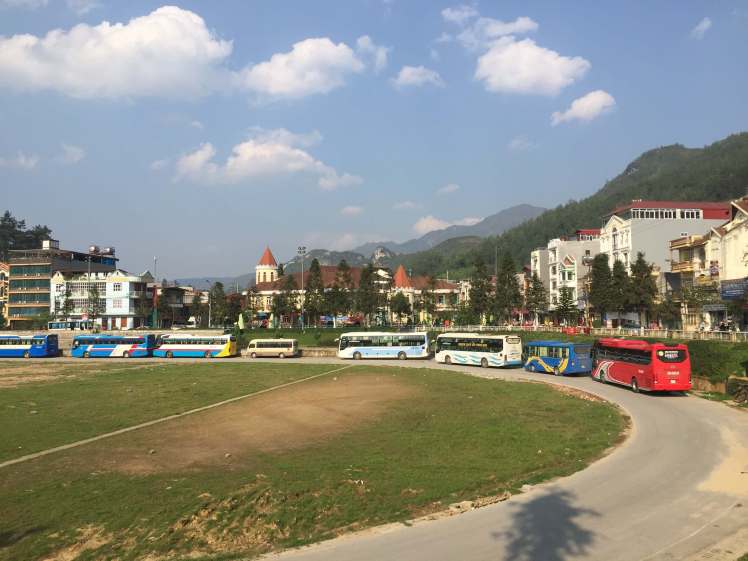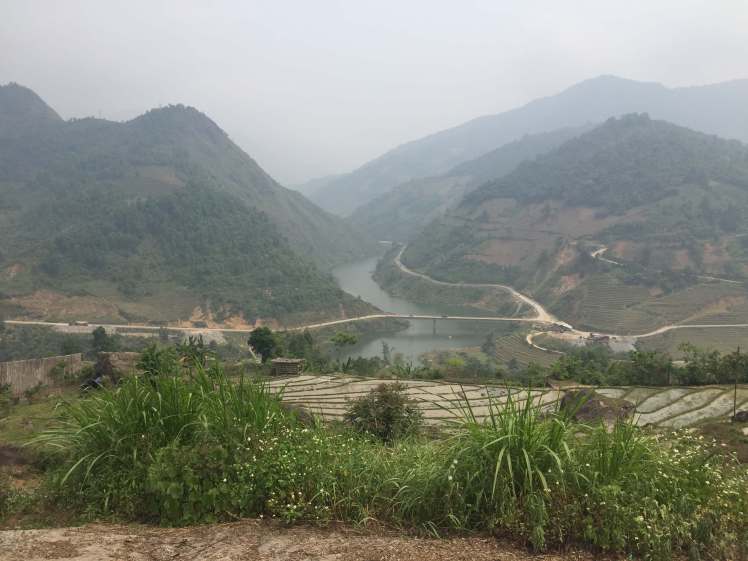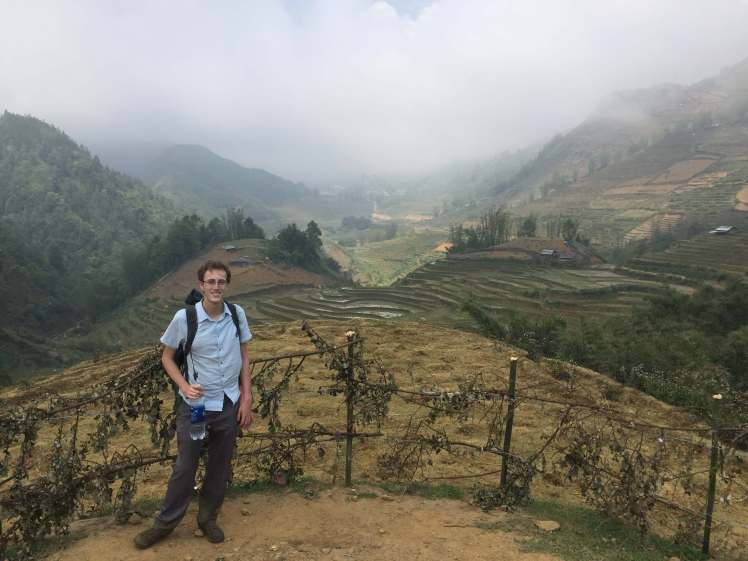I kicked off my month in Việt Nam with a day of relaxation and errands in the capital Hà Nội before boarding the overnight Pumpkin Express train to the town of Lào Cai, on the northwest border with China. After spending so much time on Indian trains, the Vietnamese train felt luxurious, and I slept well – until the conductor came banging down the hall at 5 AM shouting “Lào Cai! Lào Cai!” Fortunately, this was the train’s final destination, so I was not in danger of oversleeping and waking up in 云南省 province across the border! One winding bus ride through the mountains later, and I arrived in Sa Pa town, a hilltop hamlet built by the French colonists as an escape from the summer heat on the coast.

In a small office amid Sa Pa town’s maze of hotels, I met up with Lily, who would be my guide for the next three days. After a brief introduction and an overview of the plan, we set off on foot. Just five minutes later we had left the high-rise hotels and construction sites behind and were making our way downhill through fields of vegetables. As all the hotels suggest, Sa Pa is filled with tourists, and hundreds of them funnel into the narrow trails leading out of town each morning. Lily grew up in this area, though, so she knows the trails well, and we quickly left the crowds behind. She assured me that Mount Fansipan, Vietnam’s highest peak, was towering above us, but the fog was thick as we descended into the valley, so I focused instead on the terraces that were beginning to spread out on the hillside around us.


These hills are primarily inhabited by some of Vietnam’s fifty-plus minority tribes that have unique cultures, and languages that are different from the Vietnamese language. One prominent group is the Dao (pronounced “Zao”), often known as “Red Dao” for the large red hats that the women wear. My guide Lily is a member of the H’Mông tribe; this tribe is often referred to as “Black H’Mông” due to the black leggings that the women wear. Both the Dao and the H’Mông wear traditional clothing embroidered with colorful rectangular patterns. While we were walking through the valley, Lily explained her culture to me. Many of the H’Mông people retain their traditional animist religion, and each village has a shaman who helps to ward off evil spirits at the villagers’ houses using a variety of rituals. I was fortunate to witness some of these rituals along the way, and also to visit a shaman’s personal shrine containing an assortment of objects used in the various rituals.
Being a minority culture spread across several Asian countries including Vietnam, China, and Thailand, the H’Mông have often been the subject of discrimination and oppression from the state level. In addition to this discrimination, H’Mông women are often forced into arranged marriages – this is sometimes taken to extremes when men kidnap the women they want to marry, forcing them to either marry or bring shame upon the family. Fortunately, the situation has been improving in recent years. The company that Lily works for, Sapa Sisters, is owned and operated by local H’Mông women, and all of the guides are from the nearby villages. This empowers the local minority women and gives them increased opportunity and freedom. Lily, at least, seems to be happy; she introduced me to her fiancé and showed me around the home that they are building together and plan to use as a guesthouse for trekkers.
As Lily and I continued our trek down into the valley below Sa Pa town, the terraces on the hillside became more pronounced until it felt like we were scrambling down a giant’s stairway. On such steep terrain, the terraces are necessary for growing rice, the staple crop of Vietnam, as rice must be grown in flooded fields. The farmers build earthen berms around the front of each terrace to hold the water in. Up in the mountains where the climate is rather cool, the rice is harvested only once per year (instead of two or three times as in warmer climates), so the production here is mostly consumed locally rather than sold to other parts of the country. Though the terraces are built for rice cultivation, they are occasionally drained and used to grow vegetables such as corn, or hemp and indigo for textile production. After walking across several of the berms between drained terraces, I began to feel comfortable walking on these narrow strips of hardened soil. But, as soon as we reached a set of terraces set aside for rice, the berms became more slippery, and with one misplaced step, I ended up a foot deep in mud!



Fortunately, we soon arrived in a village where a homemade lunch was nearly ready. In this village, the influence of the former French colonists became evident. Instead of the traditional ritual objects, many of the houses in here displayed crucifixes and other Christian symbols. When the French colonists came to the region and built their hill station at Sa Pa, they converted several of the surrounding villages to Catholicism, so nowadays there is some religious diversity even within the minority tribes themselves.


At the end of each day of trekking, Lily and I checked into a guesthouse along with a few other trekkers and their guides. We all sat around the outdoor dining area overlooking the village to unwind while being entertained by the host family’s curious toddlers. On one evening (and most of the night), we were treated (or rather, subjected) to the sound of karaoke blaring up from loudspeakers at a wedding party in the village below. Meanwhile, the family was busy preparing dinner. To hold us over, they served some of the most delicious fries I have ever eaten (I know, fries in Vietnam – I was surprised too). They were fried with garlic and served with a Vietnamese sweet chili sauce – I don’t think I can ever eat fries with ketchup again! When the main meal was ready, we were treated to a huge spread of spring rolls, vegetables, and sautéed meat, and fresh pineapple for dessert. To round off the evening, the host family taught us a little Vietnamese over glasses of what they referred to as “happy water”: “Một, hai, ba, dô; hai, ba, dô; hai, ba, uống!” – “Cheers!”


At a small hilltop village with a wonderful view of the rice terraces cascading downward, Lily and I reached the end of our trek. A minibus was waiting to take us along the bumpy road back to Sa Pa town, where we said goodbye. Another minibus took me and several other trekkers back to the train station in Lào Cai, just a kilometer from China, and I was soon asleep on the Pumpkin Express, bound for the capital again. This trip was a great way to begin my visit to Việt Nam and unwind after exploring India. Whatever was causing me to not feel well the last few weeks in India seems to have passed, and so far, I’ve been off to a good start in Việt Nam. When traveling in Việt Nam, there are two options: north to south, or south to north. As Sa Pa is about as far north as the country goes, I’ll be doing the former; stay tuned for updates as I move down the coast!


One thought on “Trekking the Terraces of Sa Pa”